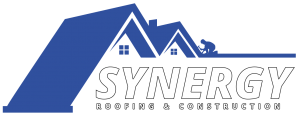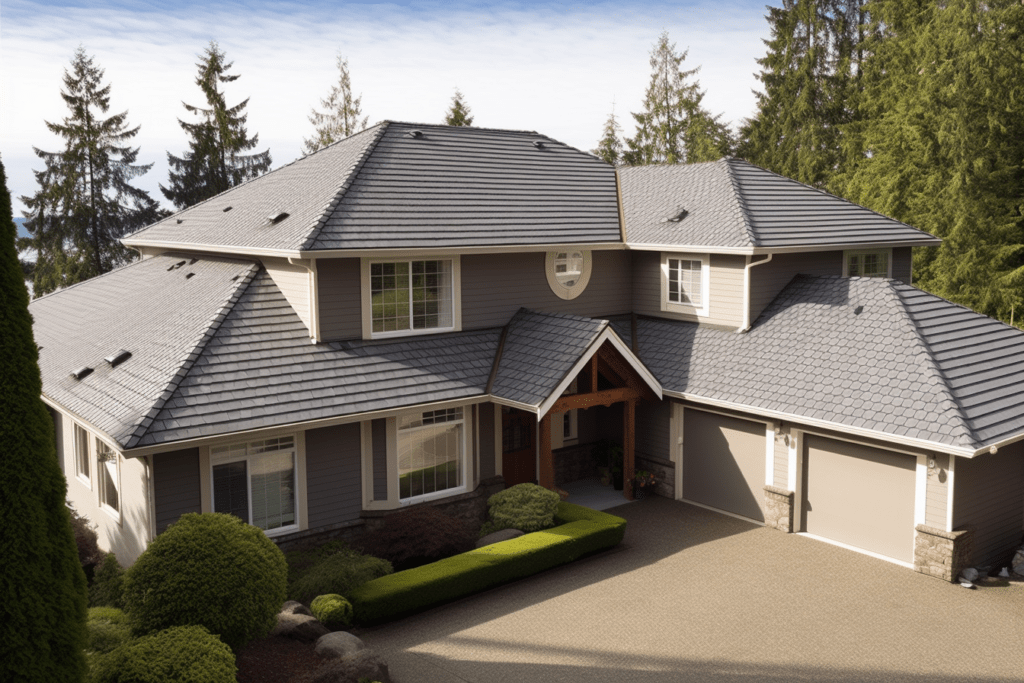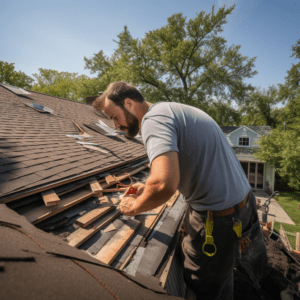Like the watchful eyes of a guardian, regular roof inspections play a crucial role in safeguarding the structural integrity and longevity of a building. Just as an attentive physician diagnoses ailments before they worsen, professional roof inspectors diligently identify signs of damage that may lead to costly repairs or even complete roof failure. This article explores the importance of quality roof inspections, the role played by professional inspectors, common roofing issues encountered, and tips for maintaining a healthy roof. Additionally, it provides guidance on how often one should schedule these vital inspections.
Key Takeaways
- Regular roof inspections are important for ensuring the longevity and functionality of a roof.
- Professional roof inspectors assess various aspects of a roof, including materials, installation, and overall integrity.
- Common roofing issues such as leaks can be promptly addressed by identifying the source and performing necessary repairs.
- Maintaining a healthy roof involves regular inspections, proper maintenance practices, and addressing potential issues before they escalate.
The Importance of Regular Roof Inspections
Regular roof inspections play a vital role in ensuring the longevity and functionality of a roof. By conducting regular inspections, homeowners can identify and address any potential issues before they escalate into more significant problems. Roof inspections provide an opportunity to assess the overall condition of the roof, including its structural integrity, materials, and drainage systems.
During a roof inspection, a trained professional examines various aspects of the roof, such as shingles or tiles, flashing, gutters, vents, and seals. They look for signs of damage or deterioration caused by weather conditions, aging, or improper installation. This thorough examination allows for early detection of leaks, cracks, loose materials, or weak points that may compromise the roof’s performance.
Moreover, regular inspections help in preventing costly repairs by addressing small issues promptly. Timely identification and resolution of minor problems prevent them from developing into major concerns that could require extensive repairs or even complete replacement.
Roof inspections also contribute to maintaining energy efficiency within homes. Inspections can reveal areas where insulation is compromised or ventilation is inadequate. Addressing these issues enhances energy conservation and reduces heating and cooling costs.
Signs of Roof Damage to Look Out For
Irregularities in the appearance or structure of a roof may indicate potential damage and should be carefully observed for signs such as cracked or missing shingles, sagging areas, or water stains. These signs can provide valuable information about the condition of a roof and help homeowners identify issues that require immediate attention. Cracked or missing shingles are common indicators of roof damage, as they expose the underlying layers to the elements and increase the risk of leaks. Additionally, sagging areas on a roof may suggest structural problems, such as weakened supports or excessive weight. Water stains, on the other hand, can indicate existing leaks or poor drainage systems that need to be addressed promptly.
It is important to note that these signs should not be ignored, as they can worsen over time and lead to more extensive damage if left untreated. Regular inspections are crucial in identifying these irregularities early on so that appropriate repairs can be made before further deterioration occurs. Homeowners should consider hiring professional roofing contractors who possess expertise in assessing roof conditions accurately and effectively. These experts have specialized knowledge regarding different types of roofs and the specific indicators of damage associated with each one.
The Role of a Professional Roof Inspector
An effective professional roof inspector plays a crucial role in identifying potential issues with the condition and structure of a roof. They are trained to assess various aspects of a roof, including its materials, installation, and overall integrity. A thorough inspection involves examining the surface of the roof for signs of damage such as cracks, leaks, or missing shingles. The inspector will also inspect the gutters, downspouts, and flashings to ensure proper functionality and prevent water damage. Additionally, they will assess the attic space for any signs of moisture intrusion or insulation problems that can affect the roof’s performance.
During an inspection, a professional roof inspector follows specific guidelines and standards set by relevant regulatory bodies. They use specialized tools and equipment to access hard-to-reach areas safely. By conducting a comprehensive evaluation of the roof’s condition, these inspectors can identify potential issues before they become major problems. This proactive approach helps homeowners and building owners save money on costly repairs or replacements in the long run.
Furthermore, professional roof inspectors provide detailed reports outlining their findings and recommendations for necessary repairs or maintenance work. These reports serve as valuable documentation for property owners when negotiating insurance claims or selling properties.
Common Roofing Issues and How to Address Them
Leaks and repairs are common roofing issues that homeowners may encounter. Leaks can occur due to various factors such as damaged shingles, clogged gutters, or inadequate flashing. When faced with a leak, it is important to promptly address the issue by identifying the source of the leak and performing necessary repairs. Additionally, proper maintenance tips can help prevent future roofing problems, such as regular inspections, cleaning gutters and downspouts, and ensuring adequate attic ventilation.
Leaks and Repairs
During the inspection process, identifying areas of concern such as leaks and necessary repairs is crucial for ensuring the overall quality and longevity of a roof. Leaks in a roof can lead to significant damage if not addressed promptly. Inspectors typically look for signs of water penetration, such as stains or dampness on interior ceilings or walls. They also examine the roof surface for missing or damaged shingles, cracked flashing, or deteriorated sealant around penetrations like chimneys and vents. Repairs may involve replacing damaged shingles, resealing flashings, or repairing faulty seals. It is important to address these issues promptly to prevent further damage and potential structural problems. Additionally, regular inspections can help identify potential leaks before they become major issues and extend the lifespan of the roof by addressing minor repairs proactively.
Proper Maintenance Tips
Proper maintenance of a roof involves regular cleaning, clearing debris, and ensuring proper ventilation to prevent the accumulation of moisture and potential damage. Regular cleaning of the roof’s surface is essential to remove dirt, leaves, and other debris that can trap moisture and accelerate deterioration. Debris buildup can also block gutters and downspouts, leading to water pooling on the roof. Additionally, proper ventilation is crucial for preventing excess heat and moisture from becoming trapped in the attic or under the roof deck. This can lead to condensation, mold growth, and rotting of the underlying materials. Adequate airflow through vents or ridge openings helps maintain a balanced temperature and humidity level within the roofing system. By following these maintenance practices diligently, homeowners can prolong their roof’s lifespan while minimizing potential damage caused by moisture accumulation.
Tips for Maintaining a Healthy Roof
Regular maintenance is crucial for ensuring the longevity and structural integrity of a roof. By implementing proper maintenance practices, homeowners can prevent costly repairs and extend the lifespan of their roofs. One important aspect of maintaining a healthy roof is conducting regular inspections. Inspections allow homeowners to identify any potential issues or damage before they worsen, allowing for timely repairs. It is recommended to conduct inspections at least twice a year, preferably in the spring and fall seasons.
During a roof inspection, several key areas should be examined thoroughly. These include checking for loose or missing shingles, signs of water damage such as stains or mold growth, and inspecting the flashing around chimneys, vents, and skylights for any signs of deterioration. It is also essential to check the gutters and downspouts for debris buildup that could obstruct water flow.
In addition to regular inspections, routine maintenance tasks should be performed as needed. This may involve cleaning out gutters regularly to prevent clogging, trimming overhanging branches that could damage the roof during storms or strong winds, and removing any moss or algae growth that can deteriorate roofing materials.
How Often Should You Schedule a Roof Inspection?
This discussion aims to explore the optimal frequency for scheduling roof inspections, the signs that indicate roof damage, and the importance of professional inspections. Determining how often to schedule a roof inspection is crucial in order to identify potential issues early on and prevent costly repairs. Additionally, recognizing signs of roof damage such as missing or cracked shingles, water leaks, or sagging areas can help homeowners understand when it is necessary to contact a professional inspector. Lastly, professional inspections offer expertise and knowledge that may not be readily available to homeowners, allowing for a more thorough evaluation of the roof’s condition.
Optimal Inspection Frequency
The optimal inspection frequency for roof inspections is determined by various factors such as the type of roofing material, local climate conditions, and the age of the roof. Different types of roofing materials have different durability and susceptibility to damage. For example, asphalt shingles may require more frequent inspections compared to metal or tile roofs. Local climate conditions also play a crucial role in determining the inspection frequency. Regions with extreme weather events like hurricanes or heavy snowfall may necessitate more frequent inspections to ensure early detection of any potential damage. Lastly, the age of the roof is an important factor to consider. Older roofs are generally more prone to wear and tear and may require more frequent inspections to identify any signs of deterioration or structural issues. Therefore, these factors should be taken into account when determining how often a roof inspection should be scheduled.
Signs of Roof Damage
Transitioning from discussing the optimal inspection frequency, it is crucial to address the signs of roof damage that inspectors should be aware of during their inspections. Identifying these signs can help assess the condition of a roof accurately and determine if any repairs or maintenance are required. Several visual indicators may signal potential damage, such as missing or damaged shingles, curling or blistering surfaces, granule loss on asphalt shingles, sagging areas, water stains on ceilings or walls, and vegetation growth. Additionally, inspectors should also inspect for interior signs of roof damage like water leaks, mold growth, and dampness in attics. By recognizing these signs early on through meticulous observation and documentation during inspections, professionals can provide accurate assessments of roofs’ conditions and recommend appropriate actions to prevent further deterioration or potential hazards.
Importance of Professional Inspections
To ensure accurate assessments of the condition and potential hazards of a roof, it is essential for professionals to conduct thorough inspections. Professional roof inspections play a crucial role in determining the overall health and longevity of a roof. These inspections involve a comprehensive examination of various components, including shingles, flashing, gutters, and ventilation systems. Professionals are trained to identify signs of damage such as cracks, leaks, or missing shingles that may compromise the structural integrity of the roof. They also assess potential hazards such as weak spots or areas prone to water accumulation. Through their expertise and knowledge, professionals can provide homeowners with detailed reports outlining any issues found during the inspection. This information enables homeowners to make informed decisions about necessary repairs or replacements to maintain a safe and durable roof structure.




